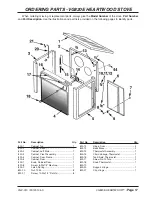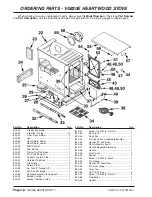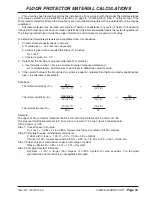
VGZ-010 / 20120105.0
VG820E HEARTWOOD™
/
Page 11
CHIMNEY CONNECTIONS continued …
CAUTION: NOT ALL FIREPLACE CHIMNEYS
ARE SUITABLE FOR CONVERSION TO AC-
COMMODATE A WOOD STOVE. CHECK WITH
A QUALIFIED EXPERT.
Many prefabricated fireplaces are of the “zero-
clearance fireplace” category. These consist of multi
layered metal construction. They are designed with
enough insulation and/or air cooling on the base, back
and sides so they can be safely installed in direct con-
tact with combustible floors and walls. Although many
prefabricated fireplaces carry endorsements from na-
tionally recognized organizations for use as fireplaces,
they have not been tested for connection to wood stove
heaters. Connecting a stove to such a device will void
the manufacturer’s warranty.
Steel-lined fireplaces are constructed with
1/4˝/6.4mm firebox liner, an air chamber in connection
with 8˝/203mm of masonry. These can be safely used
with wood burning stoves. They contain all the essen-
tial components of a fireplace, firebox, damper, throat,
smoke shelf, and smoke chamber. Many look identical
to masonry fireplaces and should be checked carefully
before connecting a stove to them.
Venting a stove directly into a fireplace does not
meet code and should not be attempted. The stove war-
ranty will be void with such an installation. Do not create
a hazard in your home by connecting in this manner.
FIREPLACE INSTALLATION
NOTE: DO NOT ATTEMPT TO ROUTE THE
CHIMNEY CONNECTOR PIPE THROUGH
THE THROAT OF THE FIREPLACE.
Directly connecting the stovepipe into the existing
masonry chimney (figure 12 “Type A” Fireplace Conver-
sion) of the fireplace is the ONLY approved method of
FIG. 12 - Fireplace Conversion
installation. This is a complicated and involved process
and to ensure safety should only be done by a quali-
fied installer.
1. An entry hole must be cut through the masonry and
tile liner with minimal damage to the liner. At least
8˝/203mm of liner must remain below the entry
position. When locating the stove and stovepipe, all
minimum clearances must be observed from com-
bustible surfaces including mantels, combustible
trim work, ceilings, and walls. Positioning the center
of the stove pipe entry into the chimney 24˝/61cm
below the ceiling should insure proper clearance
for a 6˝/152mm stovepipe.
2. Install a metal or fire clay (5/8˝/16mm minimum
thickness) thimble. Make sure the thimble is
flush with the inner surface of the chimney liner and
does not protrude into the flue (see figures 7–8 on
pages 8–9).
3. Secure the thimble with refractory mortar. The
thimble should be surrounded by 12˝/305mm of
solid unit masonry brickwork or 24˝/61cm of stone.
4. Install the stovepipe into the thimble as far as pos-
sible without extending past the flue lining (see
figures 7–8 on pages 8–9).
5. A small airspace (about 1/2˝/13mm) should remain
between the stovepipe and thimble to allow for
expansion of the pipe. Seal this airspace with high-
temperature caulking or ceramic wool.
6. Secure and seal the damper in the closed posi-
tion using high-temp caulking, ceramic wool, or
furnace cement. Also check to see if the chimney
has a clean out. If it does, make sure it is closed
and sealed as well. A leaky clean out will greatly
reduce draft efficiency.
If you have any questions regarding venting your
stove, contact the manufacturer or contact the National
Fire Protection Association (NFPA) and request a copy
of the latest editions of NFPA Standard 211 and NFPA
Standard 908. Their address is:
Battery March Park, Quincy, MA 02269.




































